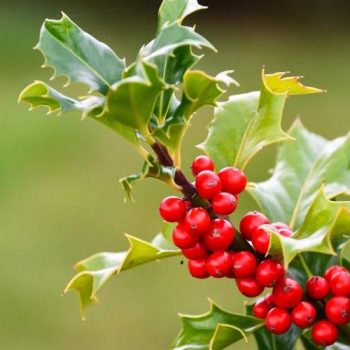
The Holly Tree
The Holly Tree is a popular sight in Europe and very easy to identify due to its evergreen prickly leaves and red berries. Hollies that are dioecious have separate male flowers on one plant and females on another, but you need both for pollination, resulting in berries. The female plants produce berries, but only if fertilized by pollen from a male plant. In other words, to produce berries, it requires two plants. So if you plan to buy a Holly tree and want berries, it’s a good idea to buy two, a male, and a female.
Hollies are easy to grow and will grow in sun or partial shade; they prefer moist but well-drained soil. The variegated varieties keep their colours better in full sun. They require minimal pruning, but a good practice is to remove any diseased or wrongly placed branches in the spring. Trim holly hedges in late summer. If you are cutting holly as a festive decoration, pick some sprigs early in winter, before the berries get eaten by birds.


The Holly Tree, renowned for being associated with symbolism, mysticism, magic, and lore, are all based within the realms of nature and are pre-Christian. The Christian symbolism of the Holly tree that is widely used today is of course Christmas, symbolically the blood of Christ turned the Holly berry red as it reportedly was white.
My favourites, the Holly King and Oak King, are personifications of the winter and summer in various folklore and mythological traditions. The two kings engage in endless “battle” reflecting the seasonal cycles of the year: not only solar light and darkness, but also crop renewal and growth. During the warm days of Midsummer, the Oak King is at the height of his strength; the Holly King regains power at the Autumn equinox; then his strength peaks during Midwinter, at which point the Oak King is reborn, regaining power at the Spring equinox, and perpetuating the succession.
Another folklore is to bring Holly into the home at Yule (The Pagan celebration of Winter Solstice); this invites the faerie folk to shelter with you in the cold of winter. But these greens must be burned on Imbolc, also called Saint Brigid’s Day, in order to ensure they don’t stick around causing trouble all year. But a small branch should be retained and hung outside the house to protect it from lightning.
Also rumoured is that Hollywood gained its name from the Holly Tree. The Holly tree wood is a common wood for making wands, and Hollywood the masters of illusion and capturing the imagination, which when all put together are attributes of magic that are also associated with the Holly tree. Is it true? I don’t know, but it does kind of make sense.

Around the base of the Holly tree, where the leaves are thick and extra prickly, it provides good dense cover and good nesting opportunities for birds. Dry leaf litter under the tree and around the trunk is ideal for hedgehogs and small mammals for hibernation.
The flowers provide nectar and pollen for bees and other pollinating insects. The leaves eaten by caterpillars of the holly blue butterfly, along with those of various moths, including the yellow-barred brindle, are a vital food source. The smooth leaves found at the tops of holly trees are a winter source of food for deer. The berries are a vital source of food for birds in winter, and small mammals, such as wood mice and dormice.
how to tell male from female holly
The Holly Tree
The trees stand on the threshold between our world and the Otherworld. They’re under the protection of the fairies, so you risk punishment if you cut them down. The only time you could bring the branches indoors was on Yule. It spelt disaster to do so at any other time. No one wants to uproot them without the fairies’ permission.
More articles here
